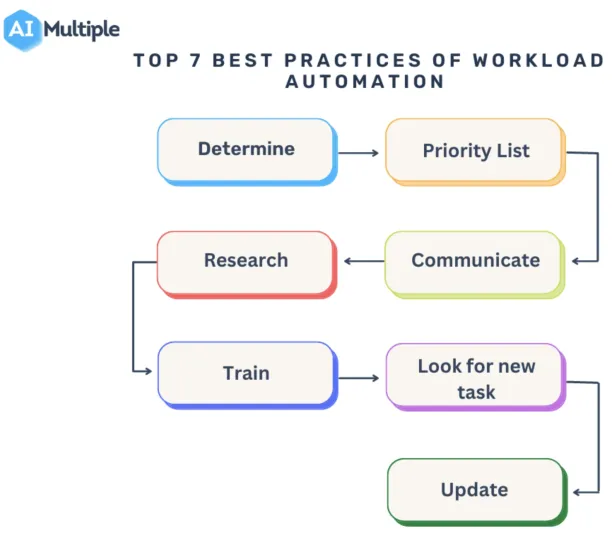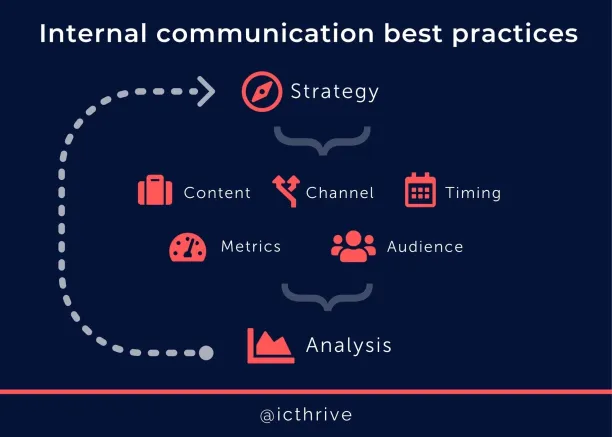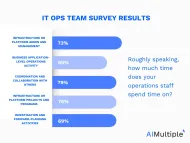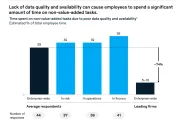Top 7 Best Practices of Workload Automation in 2024
According to Gartner, 70% of organizations will implement infrastructure automation by 2025 to increase their company’s flexibility and efficiency. Workload automation (WLA) can increase flexibility by liberating time from repetitive tasks such as preparing invoices in the finance department and efficiency by automating error-prone tasks such as data entry.
Hence, we intend to inform CEOs and executives about the top 7 best practices of workload automation to assist them in employing WLA tools in their businesses effectively.

Figure 1: Best Practices of Workload Automation
1. Determine automation opportunities
It is critical that you determine whether WLA tools can benefit your company. Hence, determine which sections or processes will benefit from WLA first. This could include investigating whether your company’s:
- HR
- Finance department
- Warehouses
- Retail establishments
- Customer services
- IT
- The marketing department etc.
To determine the time-consuming and repetitive tasks that can be automated.
To collect the information you may do surveys in various departments, for example, in the HR and finance departments. To conduct your survey, you may want to consult with your data analytics or HR team to determine the questions and analysis of its results. If you are unable to consult with them, you may consider hiring a data analytics team for this purpose.
If you cannot either, you may consider creating a survey on your own where you can ask your employees about the most time-consuming and repetitive tasks and how these tasks might be affecting their job satisfaction.
2. Determine your priorities
It may be a good practice to integrate WLA tools into your company structurally and gradually after you collect information. Because of such factors as:
- Your budget,
- Departments needs,
- Compatibility of WLA tools,
- Employee job satisfaction in various departments
Can be important to decide where to begin implementing WLA tools to utilize their benefits more successfully.
It is critical to remember to create a priority list with the factors listed above to rank your automation opportunities (and more if it is needed). You may benefit from a list to order your priorities as follows:
- Invoicing automation for the finance team to save time.
- Onboarding and offboarding automation for HR to allow them to focus on strengthening the leadership in the company.
- Data pipelining for IT to allow them to focus on sales forecasting.
- Inventory management automation for warehouses to increase warehouse efficiency and enable warehouse management to work on team building to create a happier workplace.
3. Research
After preparing a priority list, an integral part of incorporating WLA tools into your company lies in conducting good market research on WLA tools. There are more than 24 software packages right now in the market, each with unique features and costs.
It’s crucial to refrain from purchasing software with extraneous features to keep your budget tight and software with insufficient features to time from its replacement.
To determine whether the technologies you are interested in are appropriate for your business and departments, you can consult your IT department or think about going to an IT consultant.
An important factor in your decision should be the integration of the WLA tools with the software that you use in your departments such as their compatibility. For example, compatibility of WLA tools for the finance department with enterprise resource planning (ERP) tools.
Also, keep in mind to choose easy-to-use software. Difficult-to-use software can create challenges to training WLA specialists from your teams because they can increase the time spent on solving end-user problems compared to user-friendly software.
4. Communicate with your departments
After research, the best strategy to implement WLA in your company is to first inform the staff about it (see Figure 1). It’s critical that your teams understand automation and how it can improve productivity and free up time for more difficult jobs. It is important for you and your team to be on the same page about automation to work efficiently.
Figure 1: Communication practices

5. Plan for training
Finding people that are willing to learn WLA tools is crucial for their implementation after you have communicated to your personnel about them. It is standard practice to train staff from the relevant departments, particularly in the finance department and HR, which have access to sensitive data of your organization such as investments and salaries.
To have better secure data management, you might avoid giving staff from other departments needless access with the exception of the IT department in some complex software problems when they are needed to assist.
To achieve rapid technology implementation and long-term operational efficiencies, it is critical to identify candidates who are eager to learn the WLA tool and have the necessary skills. If you are unable to find suitable candidates for the implementation of WLA tools, you may consider hiring new WLA specialists.
6. Provide new tasks
A recent study indicated that implementing WLA software in HR decreased work engagement and increased stress in HR employees. According to the study, the shrinkage in HR employees’ duties following automation decreased their sense of autonomy because they were not assigned new tasks to replace them.
This had a negative impact on their work motivation. Hence, assigning new tasks to employees, such as researching new ways to attract talent and allowing them to select their tasks, can be critical to retaining their previous work motivation.
7. Report, update, and return to the start
As your company grows, it is helpful to keep your WLA tools in good working order. You may request that your IT team produce yearly reports on their operations and that your data analytics team collect data on their users’ compliances to inquire about what additional features may be beneficial to your company.
Finally, it may be beneficial to return to the determination step and your priority list in order to maximize your benefits from WLA tools.
If you have any additional questions about best practices for workload automation, please contact us at:

Cem has been the principal analyst at AIMultiple since 2017. AIMultiple informs hundreds of thousands of businesses (as per similarWeb) including 60% of Fortune 500 every month.
Cem's work has been cited by leading global publications including Business Insider, Forbes, Washington Post, global firms like Deloitte, HPE, NGOs like World Economic Forum and supranational organizations like European Commission. You can see more reputable companies and media that referenced AIMultiple.
Throughout his career, Cem served as a tech consultant, tech buyer and tech entrepreneur. He advised businesses on their enterprise software, automation, cloud, AI / ML and other technology related decisions at McKinsey & Company and Altman Solon for more than a decade. He also published a McKinsey report on digitalization.
He led technology strategy and procurement of a telco while reporting to the CEO. He has also led commercial growth of deep tech company Hypatos that reached a 7 digit annual recurring revenue and a 9 digit valuation from 0 within 2 years. Cem's work in Hypatos was covered by leading technology publications like TechCrunch and Business Insider.
Cem regularly speaks at international technology conferences. He graduated from Bogazici University as a computer engineer and holds an MBA from Columbia Business School.
To stay up-to-date on B2B tech & accelerate your enterprise:
Follow on

Comments
Your email address will not be published. All fields are required.